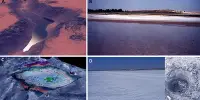Researchers discovered water vapor in the disk surrounding a young star, just where planets may be developing. Water is an essential component of life on Earth and is thought to play an important role in planet formation; however, until now, astronomers have never been able to map how water is distributed in a stable, cool disk—the type of disk that provides the best conditions for planets to form around stars.
Astronomers have for the first time measured the amount of water vapor surrounding a typical planet-forming star. The Atacama Large Millimeter/submillimeter Array (ALMA), a network of telescopes located in Chile’s Atacama Desert, enabled the discoveries. The UK ALMA Regional Centre Node (UK ARC) is hosted by the University of Manchester’s Jodrell Bank Centre for Astrophysics.
Dr. Anita Richards, Senior Visiting Fellow at The University of Manchester and former member of the UK ARC, helped the researchers validate the performance of the “Band 5” receiver system, which was required for ALMA to obtain a detailed image of the water.

Dr. Richards stated, “Directly measuring the amount of water vapor where planets are developing brings us one step closer to understanding how easily it could be to create worlds with oceans—how much water is connected to the agglomerating rocks, or is it largely added later to an almost-fully-formed planet? This type of observation requires the driest possible conditions and can only be done in such detail with the ALMA array in Chile.”
The measurements, published today in the journal Nature Astronomy, show that the inner disk of the young sun-like star HL Tauri, located 450 light-years distant in the constellation Taurus, has at least three times as much water as all of Earth’s seas.
Stefano Facchini, an astronomer at the University of Milan in Italy, who led the study, stated, “I had never imagined that we could capture an image of oceans of water vapor in the same region where a planet is likely to form.”
Co-author Leonardo Testi, an astronomer at the University of Bologna in Italy, added, “It is truly remarkable that we can not only detect but also capture detailed images and spatially resolve water vapor at a distance of 450 light-years from us.”
These ALMA images, which reveal features as tiny as human hair at a kilometer distance, enable astronomers to map the distribution of water over the disk.
A large amount of water was discovered in the area where a known gap in the HL Tauri disk exists—a location where a planet may potentially develop. Radial gaps are carved out in gas- and dust-rich disks as young planet-like entities assemble and expand. This shows that water vapor may have an impact on the chemical composition of planets developing in those locations.
However, seeing water using a ground-based telescope is difficult since the Earth’s atmosphere contains a lot of water vapor, which weakens astronomical signals.
ALMA, administered by the European Southern Observatory (ESO) and its international partners, is located at around 5,000 meters elevation and was built in a high and dry environment particularly to avoid this degradation, resulting in extraordinary observation conditions. Currently, ALMA is the only facility capable of mapping the distribution of water in a cool planet-forming disk.
The dust grains that make up a disk are the seeds of planet formation, smashing and collecting together to create larger bodies that orbit the star. Astronomers believe that where it is cold enough for water to freeze on dust particles, things cling together more easily—an excellent location for planet formation.
Members of the UK ARC are helping to upgrade ALMA, which, when combined with ESO’s Extremely Large Telescope (ELT), will provide even sharper views of planet formation and the role of water in it. In particular, METIS, the Mid-infrared ELT Imager, and Spectrograph will provide astronomers with unprecedented views of the interior parts of planet-forming disks, where planets like Earth develop.















